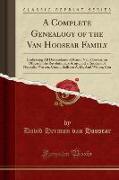- Start
- A Complete Genealogy of the Van Hoosear Family
A Complete Genealogy of the Van Hoosear Family
Angebote / Angebote:
Excerpt from A Complete Genealogy of the Van Hoosear Family: Embracing All Descendants of Rinear Van Hoosear, an Officer in the Revolutionary Army, and a Resident of Norwalk, Weston, Conn, , Ballston A. D., And Wilton, Con
The version is that its origin is from husher, because, men of strength, they were considered bullies, or from their rough exclamation when one knocks at a door "Who's yere." In 1555 Emperor Charles V. gave his son, Phillip II., of Spain, the Netherlands, which embraced Gilderland, etc. In 1668, France seized on Spanish Netherlands. In 1674 England had captured her. In 1795 Holland was conquered by France, but since 1839 there has been general peace there.
The male inhabitants of the Netherlands are of medium stature, stout form, and fair complexion. The women, tall and handsome, are very domestic in their habits and pay most scrupulous attention to the cleanliness of their houses. Perseverance and industry are striking features of the national character. The male line of the Van Hoosear descendants bear out noticeably the above characteristics, as do also the women, excepting in stature, they being a little under that of the average female Hollander.
The author has never seen the name "Van Hoosear, " either in scrip or print, spelled identically as above, except it referred directly to some of the descendants of our early ancestor from Holland. Very many similar names, however, have appeared. In 1874 an association was organized at Hudson, N. Y., called "Van Hoesen Association, " whose purpose was to investigate a certain estate left in Holland for the Van Hoesen heirs, as held by tradition. In November, 1876, another meeting was held at Hudson, at which a report was given by Mr. E. B. Humphreys, who had been appointed the Holland agent. An intermediate meeting was held at Catskill, N. Y., in 1875, and another at Gent, N. Y., in February, 1876. At the third meeting Mr. Humphreys reported that his research in Holland had developed that Maretje Jacobs "huisyrouw, " or wife of Jacob Arends den Hensden, North Holland, had left several thousand pounds, which had been deposited in the "Weeskamer" (or Orphan Chamber), in 1686, for her children. He also mentioned other estates left for unknown heirs. The next meeting was held at Hudson, in February, 1877, when it was voted to call for the quarterly dues of 50 cents each. [Extracted from circular sent out by this association].
About the Publisher
Forgotten Books publishes hundreds of thousands of rare and classic books. Find more at www.forgottenbooks.com
This book is a reproduction of an important historical work. Forgotten Books uses state-of-the-art technology to digitally reconstruct the work, preserving the original format whilst repairing imperfections present in the aged copy. In rare cases, an imperfection in the original, such as a blemish or missing page, may be replicated in our edition. We do, however, repair the vast majority of imperfections successfully, any imperfections that remain are intentionally left to preserve the state of such historical works.
Folgt in ca. 5 Arbeitstagen
